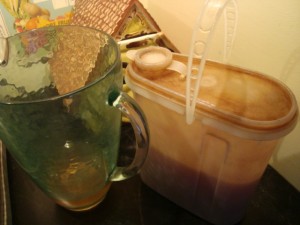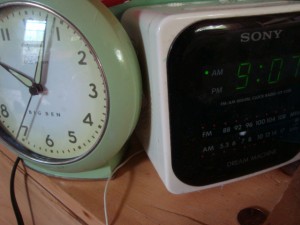Recently, our friend Laura was over at our house. As I got out the pitcher to pour some iced tea, she exclaimed, “Oh my goodness, you’ve had that Tupperware pitcher since you lived on Church Street in 1983!” She’s right. Once pale yellow, it is now stained a dark quasi-orange. This pitcher’s sole purpose in life is to go sit on the hot walkway outside on a sunny day, brewing sun tea, then come inside and sit in the fridge until the tea is gone and it’s time to start over.
There’s a little cover that snaps over the pouring spout, which affixes with two tiny little bendy plastic prongs. Those fragile little prongs have NEVER broken, in all their years of snapping into and out of place. And the pitcher, which sits on a wide base, never tips over in our refrigerator.
Compare and contrast that to the prettier, but far less functional, pitcher from Bed Bath & Beyond, circa 2008. This pitcher is made of brittle plastic and already has a crack. It sits on a small round base and has indeed toppled over in the fridge, spilling contents everywhere. It was made in China, so who knows what, if any, manufacturing guidelines were in place as it was being created. (see: poison in baby formula, lead paint in children’s toys, schools built on fault lines).
So, as homely as our stained and battered Tupperware pitcher is, it is one of my favorite household items. Functional, serviceable, loyal, and trustworthy.
The same syndrome is true in our family’s experience with alarm clocks. Old = good. New (made in China, cheap) = bad. Chris and Hugh both have the SONY model at right below, which MOB reader Lindsay also had in college in the 1970s. At one point, this alarm clock was the oldest item in Lindsay’s house, still ticking and working perfectly.
On the left is a fake-old alarm clock I ordered for Hugh from LL Bean a couple of years ago, reasoning that if it was from the venerable Maine company, the clock would be good. It wasn’t. It was made in China, and it lasted only a short time before dying.
In my world, cheap does not equal good. Old equals good. Ironically, that even means things that are marked Made in Japan, which in my childhood was synonymous with “horrible useless junk.”
Now, with truly awful crap marked Made in China, the stuff labeled Made in Japan in the 1950s and 1960s is, by contrast, the gold standard.
What is the oldest functional item in your house that you would never toss out?

